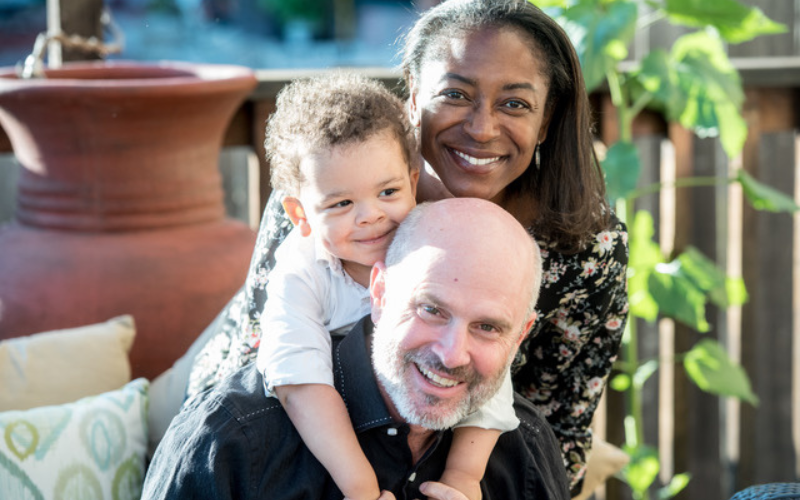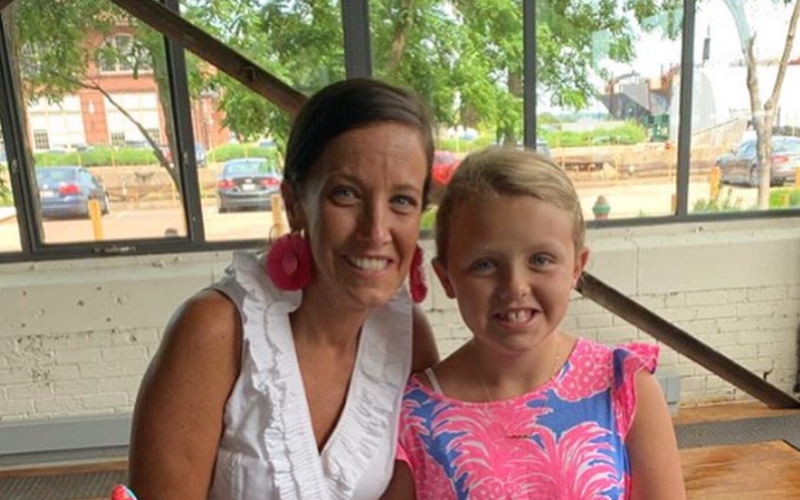By: Trish Adkins
Edie Gilger was diagnosed with neuroblastoma when she was just 6 months old. Nothing worked—chemotherapy, surgery and other treatments failed over and over again.
Edie went through three relapses before the family found themselves at the Children’s Hospital of Philadelphia.
“My husband, Nick always tells people that without Alex’s Lemonade Stand Foundation (ALSF) and without the research you support, he would not have a family. And it’s true. My daughter Edie, me, my son Kinsey—none of us would be here if it weren’t for ALSF,” said Emily, Edie’s Mom. Emily was diagnosed with the same type of neuroblastoma Edie had while she was pregnant with her son Kinsey.
Both Edie and Emily were treated for hereditary neuroblastoma by ALSF-funded researcher Dr. Yael Mosse. Dr. Mosse led a clinical trial for a drug that targeted the drivers of their cancer. That trial led to an FDA-approval and most important, it saved Emily and Edie’s lives.
Today, they are both cancer-free. Edie just turned 15 years old.
Children like Edie, who faced cancer and survived, are alive because of research. While cancers like acute lymphoblastic leukemia have a nearly 90% survival rate other childhood cancers, like the brain tumor, diffuse intrinsic pontine glioma, do not have five-year survivors, yet.
Meet four more children who were directly impacted by research funded by ASLF and supported by you:
1. Quincy
Quincy was just 4 months old when he was diagnosed with juvenile myelomonocytic leukemia (JMML), a rare type of leukemia that comes with a poor prognosis.
First attempts at getting Quincy to reach remission and be well enough for a bone marrow transplant failed. He kept getting sicker and sicker. Because of an ALSF Center of Excellence Grant, Quincy’s doctors at the University of California San Francisco had access to an advanced genetic test called the UCSF-500. The test compared the genetics of Quincy’s cancer with the genetics of Quincy’s healthy cells.
That test revealed that Quincy had a rare mutation, and that mutation had a matching drug to treat it: a therapy previously approved for use in adult liver and kidney cancers.
Trying this treatment brought about a lot of unknowns, but Quincy had no other options.
The drug worked.
Quincy is now 8 years old. Every milestone in his young life — from first steps to first words to first days of school — has been because of a treatment that saved his life.
2. Greta
Greta was 3 months old when she was diagnosed with leukemia. Greta had chemotherapy and then a bone marrow transplant, using the bone marrow of her older sister. But the bone marrow transplant would lead to liver and kidney failure. Greta pulled through and had a happy six months at home.
Then she relapsed.
Her family was referred to an immunotherapy trial at Seattle Children’s Hospital using CAR-T therapy. It was a brand-new treatment at the time. They weighed their options—and then they packed their bags, sent their pets to friends and headed to Seattle.
The trial, led by Dr. Rebecca Gardner, was funded in part by ALSF.
Greta began the treatment, which included harvesting her own T cells and then editing those cells to detect leukemia. The new CAR T cells were returned to Greta and went to work fighting the leukemia.
Now, Greta is 10 years old and cancer-free.
“We find ourselves thankful literally every day for the hopes and dreams we are seeing Greta realize!” said Maggie, Greta’s mom.
3. Taylor
When she was 11 years old, Taylor was diagnosed with a bone cancer called osteosarcoma.
The diagnosis came after a summer spent with her local swim team. Taylor had shoulder pain, and swimming seemed the logical culprit. But the pain kept increasing to the point that her arm became numb. An X-ray revealed a mass; further testing revealed that the mass was osteosarcoma.
Taylor missed most of sixth grade while she was in treatment. After nine months of chemotherapy and surgery on her right arm, she was declared cancer-free. But then 18 months later, she relapsed. This time a tumor was discovered in her lung. Taylor had surgery and chemotherapy and again she was declared cancer-free. But that would only last for a year.
The cancer once again returned, and this time, her family was desperate for answers. Those answers came from a clinical trial at Texas Children's Hospital that was made possible by an infrastructure grant from Alex's Lemonade Stand Foundation (ALSF). The trial worked.
Today, Taylor is all grown up. She graduated high school, went to college, became a pediatric nurse, married her husband, Sam and is now the mother to 1-year-old Wallace.
“It’s really surreal. Sometimes I still look at him and think, are you mine?” said Taylor.
4. Philip
Philip was 3 years old when doctors told his parents that his neuroblastoma was incurable.
His parents, Wendy and Jeff, were devastated. Philip tried chemotherapy and an immunotherapy trial. But nothing seemed to kill all the cancer cells.
They did not give up hope — hope for more time and a miracle. That hope led them to Children’s Hospital of Philadelphia and to Dr. Mossé.
Dr. Mossé, who also helped cure Edie and Emily, had turned her attention to another type of neuroblastoma and had an open clinical trial for a targeted drug. Wendy and Jeff placed Philip on the trial — which uses a drug called lorlatinib — hoping this would be everything they were looking for. While there were some mild side effects, nothing stopped Philip from enjoying a relatively regular life. He went to school and played baseball and went on his first hunting trip with his dad all while fighting cancer.
Philip celebrated his 9th birthday in December. He is cancer-free.
“Philip wouldn’t be here,” said Wendy. “This was his last shot at helping him survive.”
Updated:
May 31, 2024
First Published:



